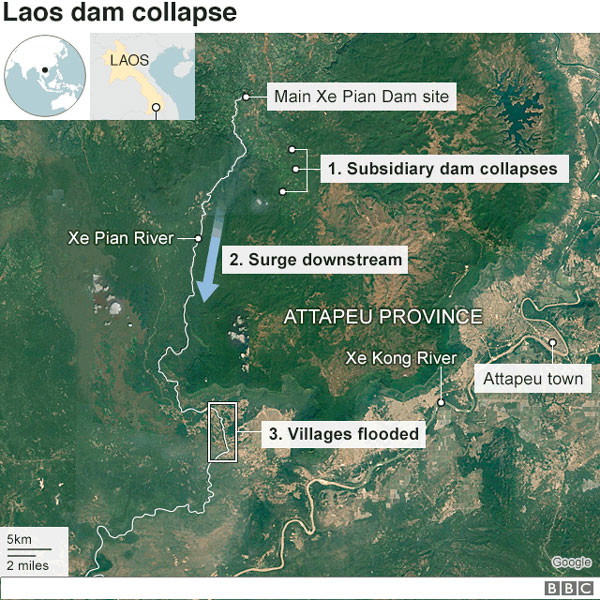[ad_1]
At least 100 people are still missing, and thousands have lost their homes.
The authorities in Attapeu province have been using helicopters and boats to try to evacuate stranded villagers.
The dam that collapsed is part of the Xe-Pian Xe-Namnoy hydroelectric power project, which involves Laotian, Thai and South Korean firms.
Local authorities have appealed to government bodies and other communities to provide emergency aid such as clothing, food, drinking water and medicine.
 |
Footage of the disaster has shown survivors huddled on roof tops of their submerged homes, or wading through water, holding children and their belongings.
One woman, seen in a video posted by ABC Laos news on Facebook, cried and prayed as she was evacuated on a boat, telling rescuers her mother was still stranded on a tree.
The dam that collapsed is an auxiliary dam called “Saddle Dam D”. It is part of a network of two main dams and five subsidiary dams in the Xe-Pian Xe-Namnoy hydroelectric power project.
The dam was 90% complete and had been set to start operating commercially next year.
SK Engineering & Construction, a South Korean company with a stake in the project, said fractures were first discovered on the dam on Sunday, before it collapsed:
Sunday 21:00 local time (14:00 GMT) – The dam is found to be partially damaged. The authorities are alerted and villagers near the dam start to be evacuated. A team is sent to repair the dam – but is hampered by heavy rain, which has also damaged many roads.
Monday 03:00 – Water is discharged from one of the main dams (Xe-Namnoy dam) to try to lower water levels in the subsidiary dam.
Monday 12:00 – The state government orders villagers downstream to evacuate after learning that there could be further damage to the dam.
Monday 18:00 – More damage is confirmed at the dam.
By Tuesday 01:30, a village near the subsidiary dam is flooded, and by 09:30 seven villages are flooded.
Ratchaburi Electricity Generating Holding, the main Thai stakeholder, said in a statement that the dam “was fractured” after “continuous rainstorm[s]” caused a “high volume of water to flow into the project’s reservoir”.
As a result, water “leaked to the downstream area and down to Xe-Pian River” about 5km (three miles) away, it added.
Laos has in recent years invested heavily in hydroelectric power – which makes up about 30% of its exports.
The government plans to double current energy production by 2020 to become the “battery of South East Asia”.
But groups warn of the project’s impact on the environment and the nations the river supports.
Source: BBC
[ad_2]
Source link
